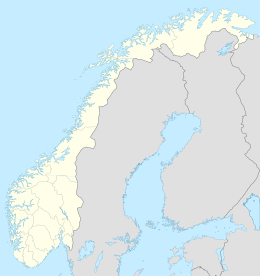 Bridge to Natholmen | |
| Geography | |
|---|---|
| Location | Sandefjord, Norway |
| Coordinates | 59°07′25″N 10°19′22″E / 59.12373°N 10.32267°E |
| Area | 0.22 km2 (0.085 sq mi) |
| Length | 0.9 km (0.56 mi) |
| Width | 0.4 km (0.25 mi) |
| Administration | |
Norway | |
| County | Vestfold |
| Municipality | Sandefjord Municipality |
Natholmen or Nattholmen is an island in Sandefjord Municipality in Vestfold county, Norway. The island is located in the Tønsbergfjorden at the entrance to the Lahellefjorden. The 0.22-square-kilometre (22 ha; 54-acre) island is situated about 5 kilometres (3.1 mi) to the east of the town of Sandefjord. The island was only accessible by boat until a bridge was installed in 1920 connecting the island to the mainland.[1][2][3] The inhabited island is the home to Knattholmen Campground (Knattholmen leirsted), which is the oldest campground in Norway.[4][5][6]
On 12 August 1923 the YWCA-YMCA (Norwegian: KFUK-KFUM) established the campground on the island.[7] The campground is called Knattholmen, which may have been the original name given to the island.[5]: 219 [2][3][8]
The island was the largest island in the municipality of Sandefjord prior to the 2017 merger with Andebu and Stokke.[7][6][3][4] It is 900 metres (3,000 ft) long from north to south, and 400 metres (1,300 ft) wide at its widest from east to west.[6] It is located between the Lahellefjord and the Tønsbergfjord. It is 6 kilometres (3.7 mi) east of the centre of the city of Sandefjord, and immediately south of the Årø peninsula.
The island is a gated community that is connected to the mainland by a private bridge. However, there is a parking lot by the gate, which can be accessed by pedestrians. There is also a public bus route to the island (route 163). Attractions on the island include Sandbukta ("sand bay"), which is a beach on its eastern side. It is also a common destination for recreational activities such as camping, paddling, sea trout fishing, hiking, and sailing. It has surrounding views of the Tønsbergfjord and the nearby Stauper islands. A former customs station on the island, known as Blåsen, has also become a landmark.[1] The island hosts annual summer camps for the Queer Youth Festival and the YWCA-YMCA Guides and Scouts of Norway.[9]
- ^ a b Reusch, Marianne (1996). 40 trivelige turer i Sandefjord og omegn (in Norwegian). Vett & viten. p. 49. ISBN 8241202849.
- ^ a b Møller, Vilhelm (1980). Sandefjord - sett fra luften. Sandefjords Blad. pp. 78, 124, and 162. ISBN 8299070406.
- ^ a b c Møller, Vilhelm (1980). Sandar: Bind II. Grend og gård 1850-1970, med tidsbilder fra næringsliv og kulturhistorie (in Norwegian). p. 310. Retrieved 3 September 2021.
- ^ a b Kruse, Bård (1998). 100 år i trekantens tegn: Sandefjord KFUK-KFUM (in Norwegian). Norges KFUK-KFUM-speidere. p. 23. ISBN 8291645078.
- ^ a b Davidsen, Roger (2010). Et sted i Sandefjord: lokalhistorisk stedsnavnsleksikon (in Norwegian). Sandar historielag. pp. 219 and 233. ISBN 9788299456777.
- ^ a b c Tollnes, Roar L. (1991). Knattholmen leirsted (in Norwegian). Sandar historielag. Retrieved 3 September 2021.
- ^ a b Gregersen, Arne W. (2 May 2017). "Knattholmen og Natholmen ville mange høre om" (in Norwegian). Sandefjords Blad. Retrieved 3 September 2021.
- ^ Bryn, Laurits L. (1926). Sandefjord og omegn (in Norwegian). Sandefjord Aktietrykkeri. p. 75. Retrieved 3 September 2021.
- ^ Trygsland, Sindre (23 July 2014). Skeiv leir for 170 unge (in Norwegian). Sandefjords Blad. Retrieved 3 September 2021.

